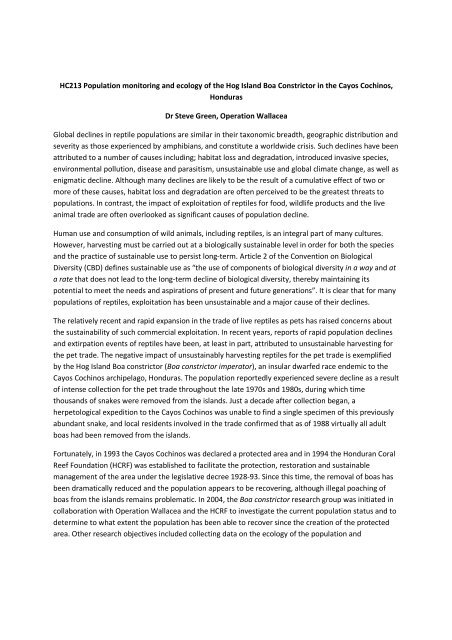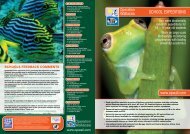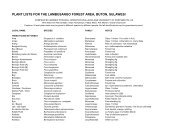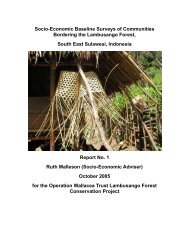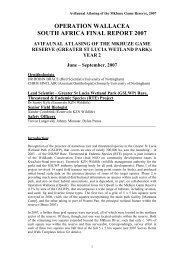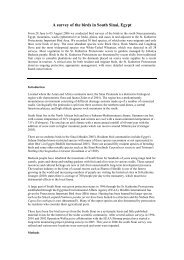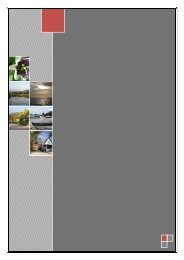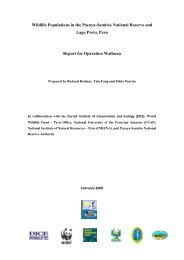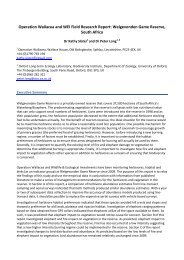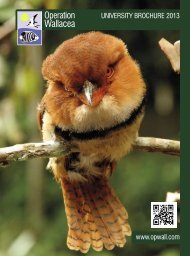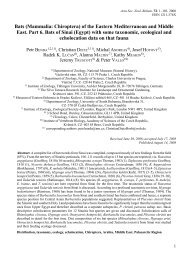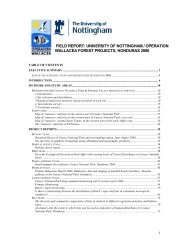HC213 Population monitoring and ecology of the Hog Island Boa ...
HC213 Population monitoring and ecology of the Hog Island Boa ...
HC213 Population monitoring and ecology of the Hog Island Boa ...
You also want an ePaper? Increase the reach of your titles
YUMPU automatically turns print PDFs into web optimized ePapers that Google loves.
<strong>HC213</strong> <strong>Population</strong> <strong>monitoring</strong> <strong>and</strong> <strong>ecology</strong> <strong>of</strong> <strong>the</strong> <strong>Hog</strong> Isl<strong>and</strong> <strong>Boa</strong> Constrictor in <strong>the</strong> Cayos Cochinos,<br />
Honduras<br />
Dr Steve Green, Operation Wallacea<br />
Global declines in reptile populations are similar in <strong>the</strong>ir taxonomic breadth, geographic distribution <strong>and</strong><br />
severity as those experienced by amphibians, <strong>and</strong> constitute a worldwide crisis. Such declines have been<br />
attributed to a number <strong>of</strong> causes including; habitat loss <strong>and</strong> degradation, introduced invasive species,<br />
environmental pollution, disease <strong>and</strong> parasitism, unsustainable use <strong>and</strong> global climate change, as well as<br />
enigmatic decline. Although many declines are likely to be <strong>the</strong> result <strong>of</strong> a cumulative effect <strong>of</strong> two or<br />
more <strong>of</strong> <strong>the</strong>se causes, habitat loss <strong>and</strong> degradation are <strong>of</strong>ten perceived to be <strong>the</strong> greatest threats to<br />
populations. In contrast, <strong>the</strong> impact <strong>of</strong> exploitation <strong>of</strong> reptiles for food, wildlife products <strong>and</strong> <strong>the</strong> live<br />
animal trade are <strong>of</strong>ten overlooked as significant causes <strong>of</strong> population decline.<br />
Human use <strong>and</strong> consumption <strong>of</strong> wild animals, including reptiles, is an integral part <strong>of</strong> many cultures.<br />
However, harvesting must be carried out at a biologically sustainable level in order for both <strong>the</strong> species<br />
<strong>and</strong> <strong>the</strong> practice <strong>of</strong> sustainable use to persist long-term. Article 2 <strong>of</strong> <strong>the</strong> Convention on Biological<br />
Diversity (CBD) defines sustainable use as “<strong>the</strong> use <strong>of</strong> components <strong>of</strong> biological diversity in a way <strong>and</strong> at<br />
a rate that does not lead to <strong>the</strong> long-term decline <strong>of</strong> biological diversity, <strong>the</strong>reby maintaining its<br />
potential to meet <strong>the</strong> needs <strong>and</strong> aspirations <strong>of</strong> present <strong>and</strong> future generations”. It is clear that for many<br />
populations <strong>of</strong> reptiles, exploitation has been unsustainable <strong>and</strong> a major cause <strong>of</strong> <strong>the</strong>ir declines.<br />
The relatively recent <strong>and</strong> rapid expansion in <strong>the</strong> trade <strong>of</strong> live reptiles as pets has raised concerns about<br />
<strong>the</strong> sustainability <strong>of</strong> such commercial exploitation. In recent years, reports <strong>of</strong> rapid population declines<br />
<strong>and</strong> extirpation events <strong>of</strong> reptiles have been, at least in part, attributed to unsustainable harvesting for<br />
<strong>the</strong> pet trade. The negative impact <strong>of</strong> unsustainably harvesting reptiles for <strong>the</strong> pet trade is exemplified<br />
by <strong>the</strong> <strong>Hog</strong> Isl<strong>and</strong> <strong>Boa</strong> constrictor (<strong>Boa</strong> constrictor imperator), an insular dwarfed race endemic to <strong>the</strong><br />
Cayos Cochinos archipelago, Honduras. The population reportedly experienced severe decline as a result<br />
<strong>of</strong> intense collection for <strong>the</strong> pet trade throughout <strong>the</strong> late 1970s <strong>and</strong> 1980s, during which time<br />
thous<strong>and</strong>s <strong>of</strong> snakes were removed from <strong>the</strong> isl<strong>and</strong>s. Just a decade after collection began, a<br />
herpetological expedition to <strong>the</strong> Cayos Cochinos was unable to find a single specimen <strong>of</strong> this previously<br />
abundant snake, <strong>and</strong> local residents involved in <strong>the</strong> trade confirmed that as <strong>of</strong> 1988 virtually all adult<br />
boas had been removed from <strong>the</strong> isl<strong>and</strong>s.<br />
Fortunately, in 1993 <strong>the</strong> Cayos Cochinos was declared a protected area <strong>and</strong> in 1994 <strong>the</strong> Honduran Coral<br />
Reef Foundation (HCRF) was established to facilitate <strong>the</strong> protection, restoration <strong>and</strong> sustainable<br />
management <strong>of</strong> <strong>the</strong> area under <strong>the</strong> legislative decree 1928-93. Since this time, <strong>the</strong> removal <strong>of</strong> boas has<br />
been dramatically reduced <strong>and</strong> <strong>the</strong> population appears to be recovering, although illegal poaching <strong>of</strong><br />
boas from <strong>the</strong> isl<strong>and</strong>s remains problematic. In 2004, <strong>the</strong> <strong>Boa</strong> constrictor research group was initiated in<br />
collaboration with Operation Wallacea <strong>and</strong> <strong>the</strong> HCRF to investigate <strong>the</strong> current population status <strong>and</strong> to<br />
determine to what extent <strong>the</strong> population has been able to recover since <strong>the</strong> creation <strong>of</strong> <strong>the</strong> protected<br />
area. O<strong>the</strong>r research objectives included collecting data on <strong>the</strong> <strong>ecology</strong> <strong>of</strong> <strong>the</strong> population <strong>and</strong>
determining <strong>the</strong> phylogenetic relationship <strong>of</strong> <strong>the</strong>se snakes to populations <strong>of</strong> B. c. Imperator on <strong>the</strong><br />
nearby Bay Isl<strong>and</strong>s <strong>and</strong> mainl<strong>and</strong> Honduras.<br />
The research is primarily focused on <strong>the</strong> smaller <strong>of</strong> <strong>the</strong> two isl<strong>and</strong>s, Cayo Cochino Pequeño (CCP), also<br />
known as Cayo Menor, where <strong>the</strong> HCRF scientific research centre is based <strong>and</strong> from where <strong>the</strong><br />
Operation Wallacea expeditions are run. However, one day per week is also spent on <strong>the</strong> larger isl<strong>and</strong><br />
Cayo Cochino Gr<strong>and</strong>e (CCG), also known as Cayo Mayor, to allow comparisons to be made between <strong>the</strong><br />
two isl<strong>and</strong>s.<br />
Visual encounter surveys (VES) for boas are conducted systematically on CCP, making sure that <strong>the</strong><br />
entire isl<strong>and</strong> is surveyed evenly during <strong>the</strong> Operation Wallacea season. VES on CCG are limited to <strong>the</strong><br />
areas <strong>of</strong> <strong>the</strong> isl<strong>and</strong> to which we have been granted access. The number <strong>of</strong> participants <strong>and</strong> <strong>the</strong> time<br />
spent searching are recorded for each VES in an attempt to quantify search effort. <strong>Boa</strong>s are also<br />
captured opportunistically at o<strong>the</strong>r times while moving around <strong>the</strong> isl<strong>and</strong>s.<br />
All boas encountered are captured by h<strong>and</strong> <strong>and</strong> ei<strong>the</strong>r placed in a cloth snake bag <strong>and</strong> taken back to <strong>the</strong><br />
field station for processing, or processed in situ <strong>and</strong> released immediately. The Universal Transverse<br />
Mercator (UTM) coordinates <strong>of</strong> <strong>the</strong> exact capture site are obtained using a h<strong>and</strong>-held Global Positioning<br />
System (GPS) in order to plot capture locations across <strong>the</strong> isl<strong>and</strong> <strong>and</strong> estimate local abundance <strong>and</strong><br />
density.<br />
Snout-vent length (SVL) <strong>and</strong> tail length (TL) are measured by stretching <strong>the</strong> snake along a tape measure<br />
fixed to <strong>the</strong> laboratory bench, or if processing in <strong>the</strong> field, by stretching <strong>the</strong> tape measure along <strong>the</strong><br />
snake. Sex is determined by observing <strong>the</strong> size <strong>of</strong> <strong>the</strong> cloacal spurs <strong>and</strong> <strong>the</strong> relative length <strong>of</strong> TL to SVL<br />
(males having enlarged spurs compared to females <strong>and</strong> relatively longer tails). If sex cannot be<br />
determined with confidence, sex is confirmed by <strong>the</strong> use <strong>of</strong> hemipenial probes. All new captures are<br />
implanted with a Passive Integrated Transponder (PIT) tag (11 x 3 mm) <strong>and</strong> <strong>the</strong> unique ten digit<br />
identification code recorded. Subsequent recaptures are identified by scanning boas using a Biomark PIT<br />
tag reader. A tissue sample is <strong>the</strong>n taken in <strong>the</strong> form <strong>of</strong> 1-3 ventral scale clips from every new snake<br />
captured <strong>and</strong> retained for genetic analysis. Tissue samples are stored in >75% ethanol in screw top<br />
plastic sample tubes.<br />
Since <strong>the</strong> initiation <strong>of</strong> <strong>the</strong> project, a wealth <strong>of</strong> data has been collected <strong>and</strong> many <strong>of</strong> <strong>the</strong> original<br />
questions about population size, <strong>ecology</strong> <strong>and</strong> phylogenetic relationships are now being addressed in<br />
detail. Students will benefit from <strong>the</strong> large volume <strong>of</strong> data available to <strong>the</strong>m from previous years <strong>and</strong><br />
may design projects in a number <strong>of</strong> possible areas. However, in particular, <strong>the</strong> long term nature <strong>of</strong> <strong>the</strong><br />
mark-recapture data set will allow students to model annual survival <strong>and</strong> detectability using <strong>the</strong> freely<br />
available s<strong>of</strong>tware Program MARK, from which population estimates can be inferred.<br />
Suggested Reading<br />
Bermingham, E., Coates, A., Cruz, G., Emmons, L., Foster, R. B., Leschen, R., Seutin, G., Thorn, S., Wcislo,<br />
W. & Werfel, B. 1998 Geology <strong>and</strong> terrestrial flora <strong>and</strong> fauna <strong>of</strong> Cayos Cochinos, Honduras. Revista De<br />
Biologia Tropical 46, 15-37.
Boback, S. M. 2003 Body size evolution in snakes: evidence from isl<strong>and</strong> populations. Copeia 2003, 81-<br />
94.<br />
Boback, S. M. 2005 Natural history <strong>and</strong> conservation <strong>of</strong> isl<strong>and</strong> boas (<strong>Boa</strong> constrictor) in Belize. Copeia<br />
2005, 879-884.<br />
Boback, S. M. 2006 A morphometric comparison <strong>of</strong> isl<strong>and</strong> <strong>and</strong> mainl<strong>and</strong> boas (<strong>Boa</strong> constrictor) in Belize.<br />
Copeia 2006, 261-267.<br />
Boback, S. M. & Carpenter, D. M. 2007 Body size <strong>and</strong> head shape <strong>of</strong> isl<strong>and</strong> <strong>Boa</strong> constrictor in Belize:<br />
environmental versus genetic contributions. In Biology <strong>of</strong> <strong>the</strong> <strong>Boa</strong>s <strong>and</strong> Pythons (ed. R. W. Henderson &<br />
R. Powell). Utah: Eagle Mountain Publishing.<br />
Boback, S. M. & Guyer, C. 2003 Emperical evidence for an optimal body size in snakes. Evolution 57, 345-<br />
351.<br />
Boback, S. M. & Siefferman, L. M. 2010 Variation in color <strong>and</strong> color change in isl<strong>and</strong> <strong>and</strong> mainl<strong>and</strong> boas<br />
(<strong>Boa</strong> constrictor). Journal <strong>of</strong> Herpetology 44, 506-515.<br />
Gibbons, W. J., Scott, D. E., Ryan, T. J., Buhlmann, K. A., Turberville, T. D., Metts, B. S., Greene, J. L., Mills,<br />
T., Leiden, Y., Poppy, S. & Winne, C. T. 2000 The global decline <strong>of</strong> reptiles, déjà vu amphibians.<br />
BioScience 50, 653-666.<br />
Green 2010 Evolutionary biology <strong>and</strong> conservation <strong>of</strong> <strong>the</strong> <strong>Hog</strong> Isl<strong>and</strong> <strong>Boa</strong> constrictor. Ph.D. <strong>the</strong>sis.<br />
University <strong>of</strong> Kent, UK. (available online at http://www.opwall.com/Library/phd%20<strong>the</strong>ses.shtml<br />
Hynkova, I., Starostova, Z. & Frynta, D. 2009 Mitochondrial DNA variation reveals recent evolutionary<br />
history <strong>of</strong> main <strong>Boa</strong> constrictor clades. Zoological Science 26, 623-631.<br />
Keogh, J. S., Scott, I. A. W. & Hayes, C. 2005 Rapid <strong>and</strong> repeated origin <strong>of</strong> insular gigantism <strong>and</strong> dwarfism<br />
in Australian Tiger Snakes. Evolution 59, 226-233.<br />
Porras, L. W. 1999 Isl<strong>and</strong> <strong>Boa</strong> Constrictors (<strong>Boa</strong> constrictor). Reptiles Magazine 7, 48-61.<br />
Reed, R. N., Boback, S. M., Montgomery, C. E., Green, S., Stevens, Z. & Watson, D. 2007 Ecology <strong>and</strong><br />
conservation <strong>of</strong> an exploited insular population <strong>of</strong> <strong>Boa</strong> constrictor (Squamata: Boidae) on <strong>the</strong> Cayos<br />
Cochinos, Honduras. In Biology <strong>of</strong> <strong>the</strong> <strong>Boa</strong>s <strong>and</strong> Pythons (ed. R. W. Henderson & R. Powell). Utah: Eagle<br />
Mountain Publishing.<br />
Schlaepfer, M. A., Hoover, C. & Dodd, C. K. 2005 Challenges in evaluating <strong>the</strong> impact <strong>of</strong> <strong>the</strong> trade in<br />
amphibians <strong>and</strong> reptiles on wild populations. BioScience 55, 256-264.<br />
Wilson, L. D. & Cruz Diaz, G. 1993 The herpet<strong>of</strong>auna <strong>of</strong> <strong>the</strong> Cayos Cochinos, Honduras. Herpetological<br />
Natural History 1, 13-23.<br />
Wilson, L. D. & Hahn, D. E. 1973 The Herpet<strong>of</strong>auna <strong>of</strong> <strong>the</strong> Islas de la Bahìa, Honduras. Bulletin Florida<br />
State Museum 17, 93-150.<br />
Wilson, L. D. & McCranie, J. R. 2004 The Conservation Status <strong>of</strong> <strong>the</strong> herpet<strong>of</strong>auna <strong>of</strong> Honduras.<br />
Amphibian <strong>and</strong> Reptile Conservation 3, 6-33.


